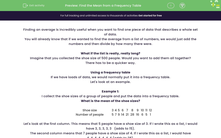Finding an average is incredibly useful when you want to find one piece of data that describes a whole set of data.
You will already know that if we wanted to find the average from a list of numbers, we would just add the numbers and then divide by how many there were.
What if the list is really, really long?
Imagine that you collected the shoe size of 500 people. Would you want to add them all together?
There has to be a quicker way.
Using a frequency table
If we have loads of data, we would normally put it into a frequency table.
Let's look at an example.
Example 1:
I collect the shoe sizes of a group of people and put the data into a frequency table.
What is the mean of the shoe sizes?
| Shoe size | 3 | 4 | 5 | 6 | 7 | 8 | 9 | 10 | 11 | 12 |
| Number of people | 5 | 7 | 9 | 14 | 21 | 28 | 16 | 6 | 5 | 1 |
Let's look at the first column. This means that 5 people have a shoe size of 3. If I wrote this as a list, I would have 3, 3, 3, 3, 3 (adds to 15).
The second column means that 7 people have a shoe size of 4. If I wrote this as a list, I would have
4, 4, 4, 4, 4, 4, 4 (adds to 28).
Can you spot the link?
To find the total, all I need to do to start with is to multiply the two numbers together!
For example: 5 x 3 = 15 and 7 x 4 = 28.
If I did this for all of them, I would get:
| Shoe size | 3 | 4 | 5 | 6 | 7 | 8 | 9 | 10 | 11 | 12 |
| Number of people | 5 | 7 | 9 | 14 | 21 | 28 | 16 | 6 | 5 | 1 |
| 15 | 28 | 45 | 84 | 147 | 224 | 144 | 60 | 55 | 12 |
Once we have this, we can work out what all the shoe sizes added together would be by adding the numbers in red. (814 )
We now have one of the bits of information we need to find the mean (what they all add up to).
All we need now is to find out how many people were asked. We can get this by adding up all the numbers in the number of people row. (112)
To find the mean, all we now have to do is to divide one of these numbers by the other: 814 ÷ 112 to get an average of 7.3.
A couple of points
Does it matter that the answer is a decimal because you can't have a shoe size of 7.3.
No, it doesn't matter because it's not a real shoe - it just represents all the others, so decimals are fine.
How do I know which way round to divide?
If you can't remember, try them both ways round. You'll get two answers: 7.3 and 0.14.
Remember that the average must be in the middle(ish) of the data, so it must be 7.3.
To summarise:
Step 1: Multiply the two columns together.
Step 2: Add all these new numbers up.
Step 3: Add up all the frequencies.
Step 4: Divide to find the mean.
Let's try some questions now.








